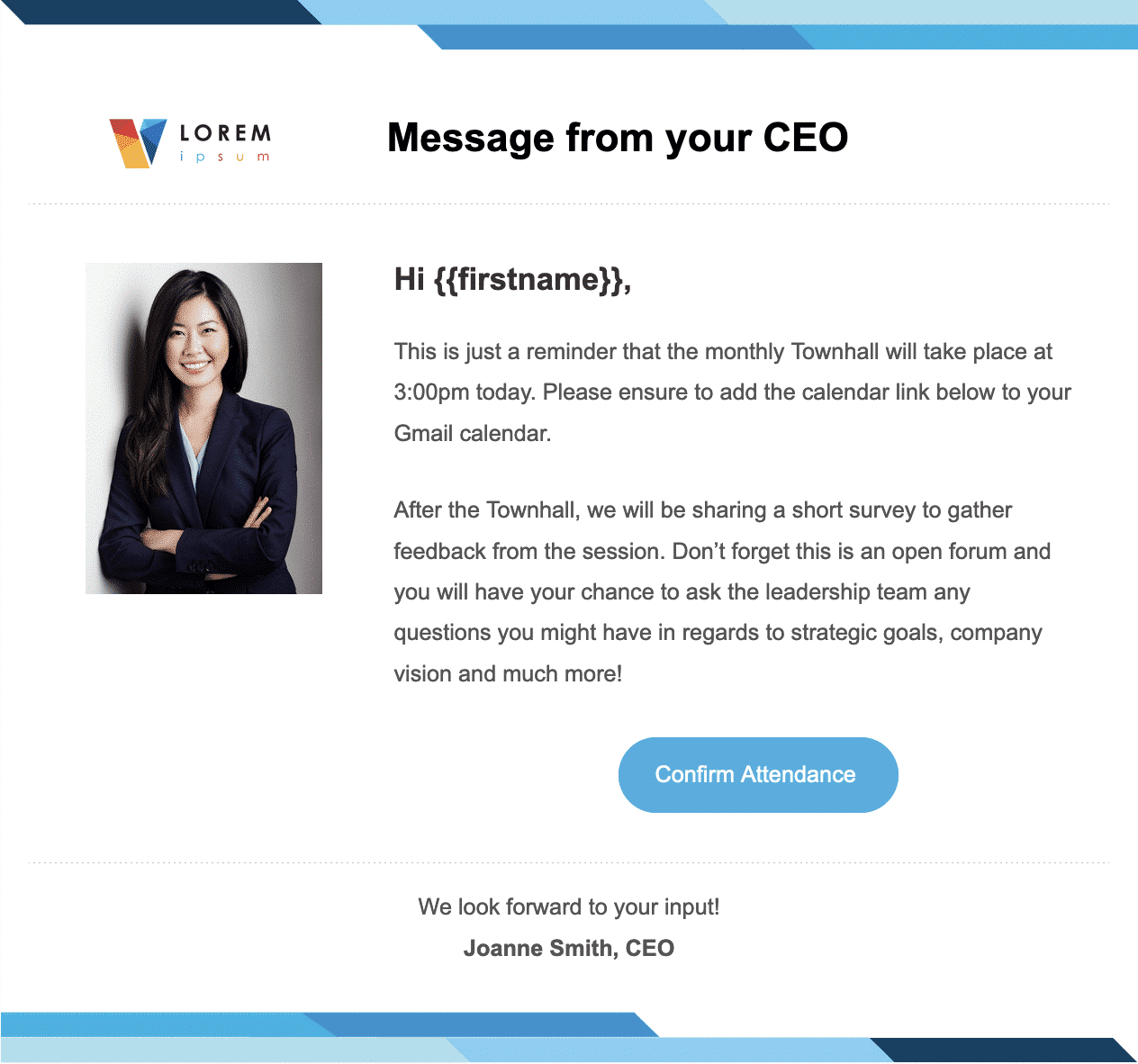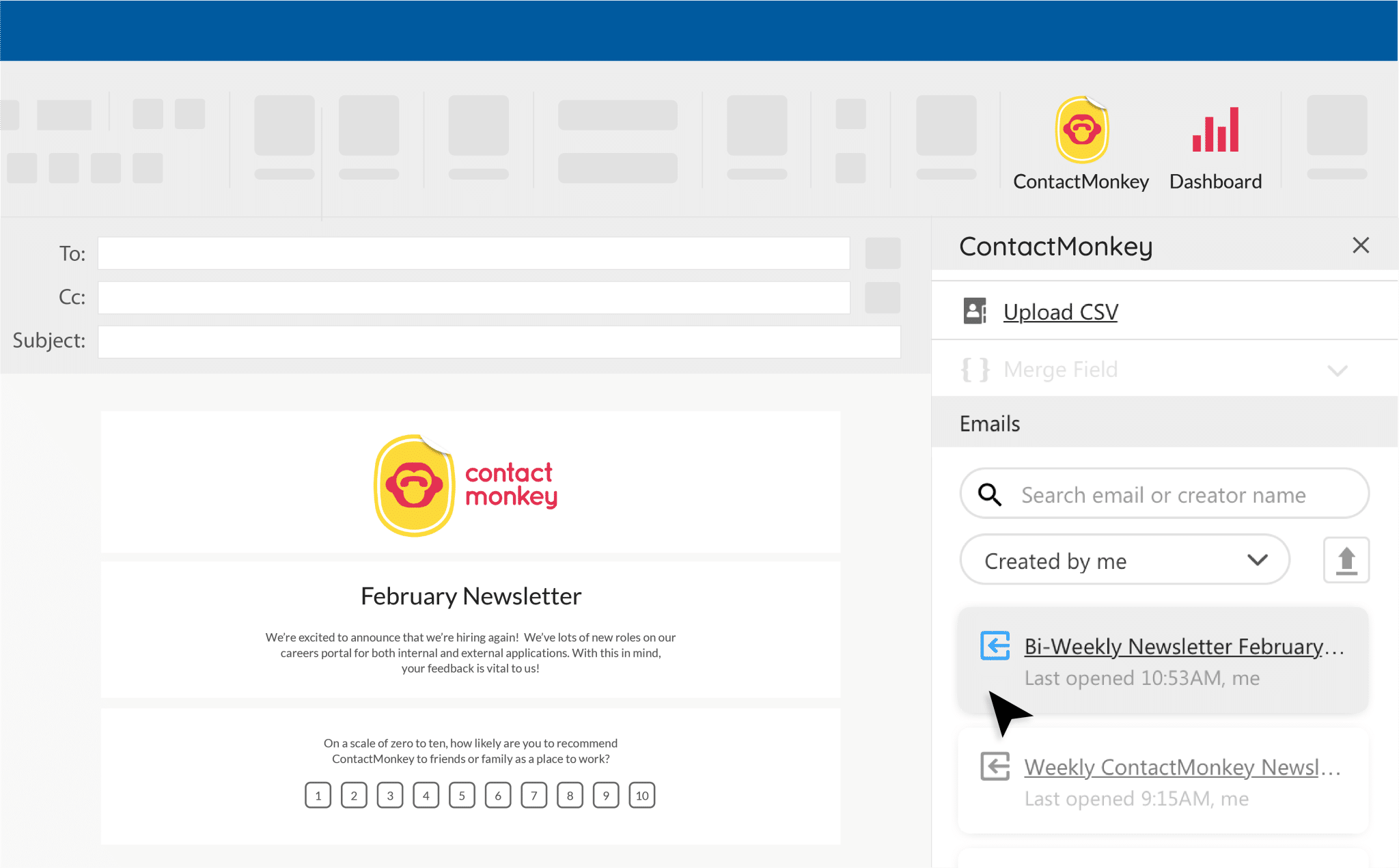Employee engagement is one of the most important drivers of productivity and growth at your business. Understand the connection between internal communication and employee engagement to unlock the full potential of your employees.
Respondents to our Global State of Internal Communications Survey for 2022 indicated that employee experience is by far their highest priority—by nearly 20% over their second highest priority.
This disparity won’t surprise anyone that’s familiar with the importance of employee engagement. Higher productivity, lower turnover, and a greater commitment to pleasing customers are just some of the many benefits of a highly engaged workforce.
We explore the role of internal communications in employee engagement and outline surefire internal communications strategies you can use to drive engagement.
Join us weekly for a live demo
Your questions about ContactMonkey, answered. Every Thursday at 12 PM ET.
What is the Role of Internal Communications in Employee Engagement
Internal communications—the way employees communicate with their business and each other—and employee engagement—the connection employees feel between themselves and their business—are deeply intertwined. Good communication facilitates greater engagement, and highly engaged employees communicate more than those who aren’t.
Employee engagement doesn’t happen by accident; it takes continuous efforts to understand what’s important to your employees and nurture a positive workplace culture.
How internal communication boosts employee engagement
Your internal communications are a crucial part of this continuous effort. According to our Global State of Internal Communications Survey for 2024, email is the most commonly used platform for internal communications. If you’re serious about increasing employee engagement, you need to prioritize your email communications.
A comprehensive internal communications plan will help you outline your employee engagement goals, provide insight on how to engage your employees, and measure your success. It will also help you pinpoint your most effective communication strategies for increasing engagement.
Internal Communication and Employee Engagement: Best Practices
Every employee is different, and every business is different. Engagement strategies that may work for one group of employees may fail miserably for another. When choosing which employee engagement communications to try at your business, understand how they’ll fit into your current internal communications landscape.
The best strategies won’t create engagement out of nothing, rather they’ll augment your existing internal communications approaches to make them more effective and engaging. As with any business initiative, it’s useful to create key performance indicators (KPIs) that you can review after a period of time to determine if your strategies are working.
Turn emails into conversations
Add surveys, polls, and reactions to your newsletters.
1. Collect employee feedback
Want to learn what motivates your employees? Just ask them! Collecting employee feedback is one of the most basic and effective ways to understand your employee opinions what really matters to your employees.
Employee feedback can take all kinds of forms, but when you make it a regular part of your internal communications it encourages employees to make a habit of giving their input. This has a double benefit for increasing employee engagement:
- Your employees get to make their voices heard and provide input over decisions that matter to them and their work.
- Your business gains valuable insight into how your employees feel about a range of issues, giving you better employee engagement ideas.
Employee engagement surveys are a great way to collect employee feedback. Using emoji reactions, thumbs up/down, yes/no, star ratings, and more, ContactMonkey turns your internal emails into two-way conversations between you and your employees:

Pulse surveys are a great way to collect focused feedback without having your employees have to complete a lengthy survey. You can also use your emails to collect anonymous feedback which gives your employees a judgment-free venue to share their thoughts and concerns. All of this can be done easily with ContactMonkey’s email template builder. Discover the benefits of employee engagement surveys that ContactMonkey can help you set up.
2. Consistency is the key to engagement
People are creatures of habit, and whether you like it or not, your employees are people. A steady routine clears one’s mind of distractions, and allows them to put more focus into whatever they’re doing rather than planning their time.
Whatever internal communications you send to your employees, do so on a regular basis. From weekly, to monthly, to yearly emails and email newsletters, ensure that you send them on a predictable schedule. This way your employees will know what to expect and when.
Combine an internal communications calendar with scheduled email sending to shore up the consistency in your employee emails:

This way you can ensure that your messages are sent at the best time to send internal emails so you don’t overwhelm your employees with your recurring and asynchronous communications. It also gives you more time to plan future employee emails so you’re not scrambling for content at the last minute.
Looking to improve employee engagement with newsletters? Explore these employee engagement newsletter strategies you can implement with ContactMonkey.
See ContactMonkey in action
Boost employee engagement right from your inbox.
3. Responsive design
More employees are using mobile devices to view internal communications than ever before. To ensure that your employees aren’t missing your internal communications (or avoiding them because they’re difficult to interact with), ensure that your emails are fully viewable on mobile devices.
Using HTML internal email templates is a great way to create amazing-looking emails that display without error on all devices and email service providers. With ContactMonkey, you can build responsive internal comms templates that look amazing on mobile devices.
You can use the Preview feature within our email template builder to see how your email will display on mobile devices:

Build mobile-friendly emails that your employees will actually look forward to receiving in their inboxes.
4. Personalize your employee emails
No one likes receiving an email obviously meant for hundreds of thousands of other recipients. Personalized emails with custom subject lines have a significantly higher open rate than those that don’t, which should make this decision easy for you.
Using merge tags, you can personalize the subject line and body copy of your emails according to who they’re being sent to. With ContactMonkey, all you have to do is insert a merge tag into your email copy or subject line:

This little step can make a huge difference with your email engagement. With more employee eyes on your emails, your organization will be more plugged into the latest news and announcements at your business.
In addition to personalizing your emails, you can increase email engagement by targeting only relevant employee using internal email list management. These lists also effective at reducing the number of irrelevant emails your employees receive.
Create custom email lists using ContactMonkey’s List Management feature. Custom lists created with ContactMonkey integrate with your Human Resource Information System (HRIS) like Workday and ADP, as well as Azure Active Directory, so your lists update automatically.
To take it one step further, you can can even send the same version of an email, but in multiple languages to reach your global internal audience with our Multi-Language Email feature. Multilingual emails for internal communication help drive engagement and connection with your global employees.
7 ways to get genuine employee feedback in surveys
Will your people tell the truth? Here’s how to build trust.
5. Design stellar emails
Show don’t tell. You have limited space within your emails to communicate the information you need to, so your email design needs to maximize the space you’re provided with.
Email design can be a tricky process. Designing great-looking emails while avoiding common email rendering issues in Outlook can be a huge challenge for those unfamiliar with HTML. With ContactMonkey’s drag-and-drop email template builder, you can create stunning emails without any coding knowledge. Email design is super easy in our builder:

Every email you create in our builder will be reusable as a Gmail or Outlook email template, which can save you loads of time and effort on recurring emails.
Not sure what content to include into your email? Try using ContactMonkey’s OpenAI ChatGPT integration to generate unique content for your employee emails and save time on email writing.
6. Measure Employee Net Promoter Score
In addition to employee surveys, you can use your internal communications to collect myriad employee engagement data. One of the most important measures of employee engagement is your business’ Employee Net Promoter Score.
This engagement metric tells you how likely your employees are to recommend your product or service to friends and family, and measures whether they’d recommend your business as a place to work for others. We recommend using an eNPS survey software like ContactMonkey to embed an eNPS in your employee newsletter on a yearly or quarterly basis to compare your employee engagement over time:

eNPS gives you an idea of how connected your employees are to their work and workplace, which is one of the most effective indicators of employee engagement. Learn what else you can accomplish with the best employee engagement platforms.
Plan like a pro: 2024 Internal Communications Calendar
Your blueprint for meeting KPIs.
7. Track your internal emails
So far we’ve discussed the qualitative aspects of internal communication and employee engagement. But now let’s look at the quantitative side of things. Conducting an in-depth employee engagement analysis helps organizations identify key drivers of performance.
Email tracking lets you combine your employee feedback with hard data to get a complete view of your internal communications landscape. Measure open rates, click-through rates, read time, opens by device and location, most engaged departments, and more to pinpoint your best performing emails and where you need to improve.
Tracking employee engagement data and benchmarks helps you identify areas of improvement and celebrate successes that foster a positive work environment.
All of your internal email metrics are visualized within your ContactMonkey analytics dashboard:

Email tracking can inform a data-based approach to internal communications, where you set specific goals and can measure your success. This is crucial for proving the importance of internal communication and employee engagement.
Does your organization have internal or external regulations around email privacy? Using ContactMonkey’s anonymous email tracking, you can still gather email metrics while protecting your employees’ privacy.
8. Communicate your company culture
As we mentioned earlier, aligning your internal communications with your company culture is crucial in order to grab your employees’ attention. Your employees are far more likely to pay attention to communications that they feel are authentic and meaningful.
There are numerous ways you can demonstrate your company culture in your internal communications. Feature communications from leadership to connect your employees to management and demonstrate the values of your company:

You can also analyze your employee feedback and employee engagement stats to identify high-engaged employees to act as internal influencers. Internal influencers act as sort-of spokespeople for leadership to their coworkers, sharing important information and communicating employee feedback back to leadership. Internal influencers help encourage communication between employees and the business, and can effectively gauge employee engagement.
9. Balance communication channels
We’ve focused primarily on email communications due to its prevalence in internal communications. But there are myriad other communications channels that comprise your internal communications landscape.
Face-to-face conversations, SMS employee communications, phone calls, intranets, video meetings; these are all important aspects of your internal communications. To get the most from all of these, it’s important to balance their use so your employees can get information quickly and easily without being overwhelmed.
As we mentioned before, an internal communications planning calendar can help organize your communications across all your channels. You can download a free template for your planning by clicking here.
10. Make your company events exciting
We’ve talked about internal communications tools and practices for increasing employee engagement, but let’s look at actual internal communications content ideas to grab your employees’ attention.
Company events—both in-person and remote—are crucial parts of any business. They’re also where your employee engagement situation reveals itself. Events with engaged employees can provide terrific insight and ideas for improving your business, and can increase the connection employees feel with one another.
Plan engaging company events by applying employee engagement ideas to your planning process. Using ContactMonkey, you can embed event invitations into your employee emails and even collect employee comments about your upcoming event:

Add games are rewards to events when applicable to drive engagement and camaraderie. Learn more about how you can use gamification to engage employees.
For example, try introducing a shout-out portion at your next company town hall where employees can recognize each other for excellent work or effort. Hold a draw where employees that were shouted out are randomly selected to win a gift card or other prize. Not only does this encourage engagement during your events, but it motivates employees to give extra effort to earn a shoutout at the next company town hall.
11. Prioritize respect and kindness in your internal communications
This strategy may seem like a truism. But many efforts for greater efficiency at work often overlook the fact that your employees are unique people with individual values. Ensure that your internal communications—both content and method—respect your employees’ time and values.
Fundamentally, your internal communications need to be based on understanding your audience. We’ve talked about how you can use employee feedback to find effective ways to engage your employees. Carefully considering your employees opinions and requests, acting on them in a timely manner, and communicating your response to them are crucial for creating a workplace culture of mutual respect.
Boost Employee Engagement with ContactMonkey
We’ve mentioned how features of ContactMonkey’s internal communications software can help you turn your internal emails into a driving force of employee engagement. ContactMonkey stands alone as an all-in-one internal communications tool that lets you create, send, and track your employee emails and newsletters. All of this information can be included within an internal communications buyer’s guide.
Your internal communications can also be used to shore up your IT security via instant alerts and phishing awareness reminders.
ContactMonkey fits seamlessly into your existing Outlook or Gmail inbox, so there’s no need to migrate your internal emails away from your preferred platform. It’s super easy to import emails from our email template builder into your inbox using the ContactMonkey sidebar:

ContactMonkey is super easy to set up and start using, so if you think your business could benefit from a dedicated internal communications software, don’t hesitate to sign up for a free demo. You’ll be set up with a meeting in less than 24 hours.
Emails employees want to open
Prioritize Internal Communication and Employee Engagement
We hope you now have a slew of new strategies you can use to enhance your internal communication and employee engagement. Easily improve your employees’ experience, drive growth using your emails and newsletters, and show leadership the real ROI of employee engagement.
There are countless ways you can improve employee engagement at your organization, so choose methods that would appeal to your employees and mesh with your existing company culture.
Want to see ContactMonkey in action? Book a free demo to see all that ContactMonkey can do to take your internal communications to the next level.


